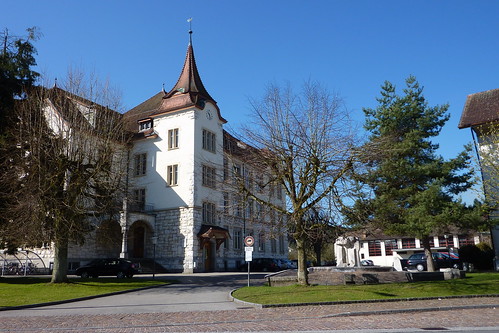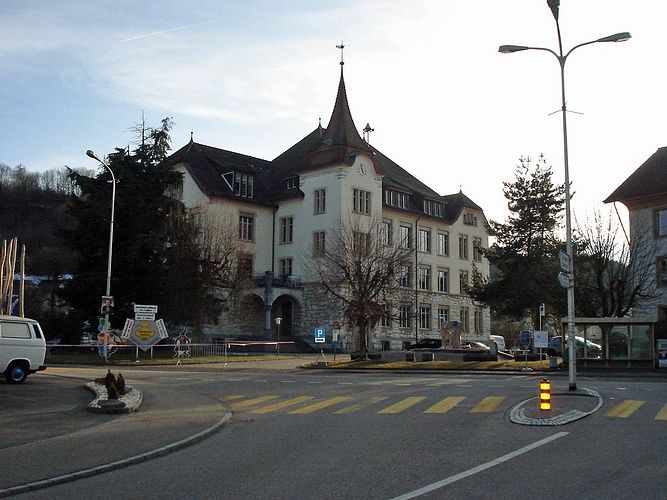Brittnau
Brittnau
Brittnau (Swiss German prɪt ː ˌ nɔu ) is a municipality in the district of Zofingen in the canton of Aargau. It is located in Wiggertal and borders the Canton of Lucerne.
Geography
The village center is located immediately west of the Wigger on a raised side terrace. Parallel to the Wigger, at a distance of 250 meters on average, flows the Altachenbach, which also forms the border with the Canton of Lucerne. The flat, elongated area in between is entirely built over. One kilometer north of the village center is located on the western edge of the Wigger level of district hardware. West of the plain stretches a hilly area with the Chilchberg ( 583 m above sea level. M. ), the Stockhubel (546 m above sea level. M. ) and the Schürberg (532 m above sea level. M. ). Both the intervening valleys ( trenches and suburban ) and the high level of Schürbergs are also overbuilt. At the far south of Heidenhubel rises (614 m above sea level. M. ), an arm of the board Schellenberg.
The valley zone and the Schürberg considered historically as the " inner community ". To the west of the three hills ( in the catchment area Pfaffneren ) is the so -called " external community ." This includes the small hamlets and isolated farms Bergacker, Bösenwil, Bötschishalden, Fennern, Geiss Bach, Grod, Leidenberg, arbitrary, Mättenwil, Rossweid, Sennhof and Wilacker.
The area of the municipality is 1367 hectares, of which 473 hectares are forested and built over 162 hectares. The highest point is located on the Heidenhubel to 614 meters, the lowest point at 433 meters at the Wigger.
Neighboring municipalities are Murgenthal in the West, Vordemwald the northwest, Strengelbach in the north, Zofingen in the northeast and the Lucerne Wikon communities in the east, Langnau at Reiden in the south and Pfaffnau in the southwest.
History
Findings on the Chilchberg evidence of a settlement during the Neolithic, on the Schürberg Roman coins and a alamannisches grave were discovered from the 7th century. The first mention of Pritinuova place in the year 893, in a toboggan interest of women Minster in Zurich. This local form of the name goes back to the Old High German term for " water near land of Prito » back.
The foundations of the church date from the period around the year 1000. Brittnau The village and the surrounding hamlets were at that time part of the Office Aarburg, which was owned by the Counts of Frohnburg. They sold the office in 1299 to the Habsburgs, who possessed so high justice. The lower courts they shared with the Lords of Büttikon, who resided at the nearby castle Wikon.
1415 conquered the Swiss Aargau; The area around Brittnau belonged now to the subject territory of Berne, the so-called Bernese Aargau. 1481 sold the Lords of Büttikon half of their right to rule the people of Berne, 1516 Berne the rest now exercised sole power over Brittnau from 1528 and led the Reformation. The monastery of St. Urban ( in the field of Catholic prior Lucerne located ) but remained the primary landowners and feudal lord. On July 26, 1547, a devastating fire destroyed the village, which was then rebuilt.
In March 1798, the French marched into Switzerland, the disempowered " Gracious gentlemen " of Bern and proclaimed the Helvetic Republic. The west of the Wigger situated part of the Office Aarburg first belonged to the district of Langenthal in the Canton of Bern and was then added to the canton of Aargau in March 1803.
Around the middle of the 19th century large parts of the population were impoverished. Alone 1851-1855 155 inhabitants were forced to migrate to North America to reduce welfare costs. The railway line Aarau- Olten- Emmen bridge was indeed opened on June 9, 1856, but until 1910 Brittnau received a railway station (along with Wikon ). After a growth phase up to about 1930, the population stagnated for several decades. Increased growth since the opening of the A2 motorway in 1980 is detected again; the community develops more and more into a suburb of Zofingen.
Attractions
A native of the Middle Ages the church was completely destroyed in the big fire in 1547, only a small part of the north wall was preserved. The completion of the new church was delayed until 1585th In 1641 the nave was extended by one -third.
On the banks of the Wigger is the mill, built in 1603, a solid construction under a pitched roof buckled. The most striking feature is the cultivated mind octagonal stair tower with a pointed roof tent. In Ausserdorf is a 1752 erbauter wooden granary.
By 1927 wild storks in Brittnau were home, then they were gone. 1960 subscribed for in the whole of Switzerland reintroduction experiment four Algerian young storks, the stork's nest newly created on the gym. In decades of trying their offspring were reared in a specially created pen and settled down again. After loosening the enclosure attitude 1995, the storks were given only in exceptional cases and feed each coated in late autumn to their winter quarters. Since 2001, the reintroduction attempt is considered successful, storks are now part of the local scene and hibernate partially on site. The enclosure was demolished in the spring of 2007.
Coat of arms
The blazon of the municipal coat of arms is: ". In red over green Dreienberg white oblique Links River » The helical flow first appeared in 1581 on the calyx of the parish church of Brittnau. 1811 was added to the parish seal a triple mount. 1963 suggested the cantonal coat of arms Commission to waive the three- mountain, but what the council refused.
Population
Population development:
On December 31, 2013 3782 people lived in Brittnau, the proportion of foreigners was 9%. At the 2000 census, 65.9 % were reformed, 21.3 % Roman Catholic, and 1.1 % Muslim; 0.9% belonged to other faiths. 96.1 % identified German as their main language, 1.2 % speak Italian, 0.7 % Portuguese.
Politics and Law
The Assembly of the voters, the municipal assembly, shall exercise the legislative power. Executive authority is the five-member council. His term of office is four years and he was elected in Majorzverfahren ( majority voting procedure) by the people. He leads and represents the community. To this end, he implements the decisions of the municipal assembly and the tasks that were assigned to him by the cantonal and federal.
For litigation, the District Court has jurisdiction Zofingen. At the local level there is a justice of the peace, who is also responsible for the communities Strengelbach and Vordemwald.
Economy
In Brittnau there according to census of 2008, around 620 jobs, of which 29% in agriculture, 16 % in industry and 55 % in the service sector. Although numerous small and medium-sized industrial and service enterprises have settled agriculture possession still of great importance. The municipality has the second largest arable land in the canton. Most workers are commuters and work in Zofingen and the surrounding area.
Traffic
Brittnau is accessible via side streets, but is only ever two kilometers from the main road 2 ( Olten- Lucerne ) and the Reiden connection to the A2 motorway. From Zofingen train station provides two lines of society SDR on different routes to Brittnau. The hamlet of Grod and arbitrary are Zofingen -St by the line. Urban opened up. East of the village center, on the territory of the municipality Wikon, the SBB train station is Brittnau - Wikon ( line Luzern- Olten ). Here hold regional trains to Olten and Luzern.
In the years 2009/10 extensive flood protection measures are carried out between the main street bridge and the mouth of the mill channel in the Wigger. The aim of this multi-million dollar construction work is to sustainably protect the flood far extended in recent years affected residential areas. For this, the river terrain is widened on the west bank of the Wigger by several meters, stabilizes the embankment with stone blocks as well as the village road bridge and a smaller pedestrian bridge completely renewed. In addition, the location on the banks Wigger cycling and footpath must be laid by several meters.
Education
The municipality has two kindergartens and three school houses in which all school levels of compulsory elementary school can be completed. The nearest Canton schools ( high schools ) are located in Zofingen, and Aarau.
Personalities
- Ernst Aeppli (1892-1954), psychoanalyst
- Emma Kunz (1892-1963), medical practitioner and artist








